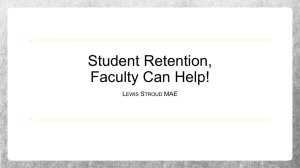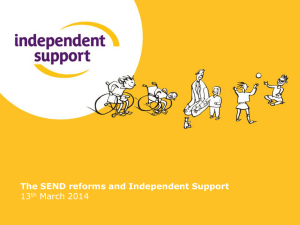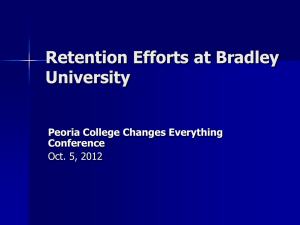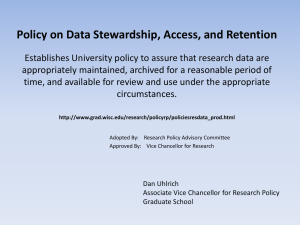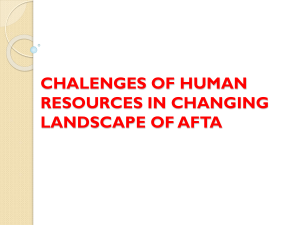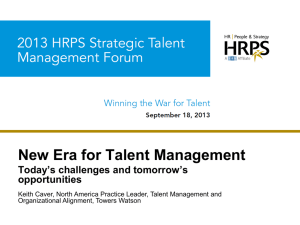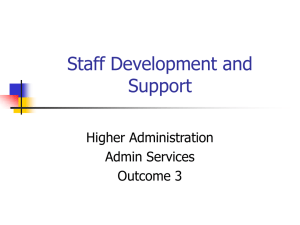Attraction & Retention
advertisement
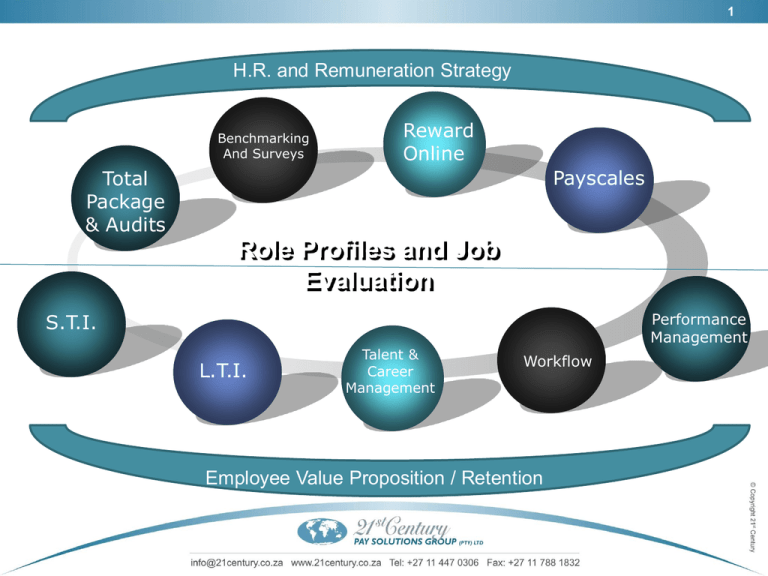
1 H.R. and Remuneration Strategy Benchmarking And Surveys Reward Online Payscales Total Package & Audits Role Profiles and Job Evaluation Performance Management S.T.I. L.T.I. Talent & Career Management Workflow Employee Value Proposition / Retention 2 ttracting and Retaining Top Talent 3 Sources Reuters Department of Home Affairs Business Report Goldfields Wits Business School 4 5 Globally, the average time that CEO’s remain with one company for 6 7 The number of Gold Mining firms in South Africa, compared to the 1,600 in China 8 9 % of global leaders eligible for retirement within the next 5 years 10 11 The number of Engineers and Artisans that Eskom lost last year 12 13 The predicted shortfall of qualified artisans in South Africa by 2010. 14 15 The number of South Africans who attended this years Australian emigration expo. 16 17 The number of positions which cannot be filled from within the country because of the current skills shortage. 18 19 The number of people working in the Financial Sector in South Africa. At any one time there are more financial sector job vacancies worldwide than this. 20 21 Shortfall of qualified medical practitioners worldwide 22 23 Value of active construction projects in the Gulf Co-Operation Council Countries 24 Effective Individuals Great Organisations •Sustain performance •Are focused and disciplined •Engage employees •Are trustworthy Define themselves in the market •Possess judgement •Are proactive Inspired Leaders •Engender trust Clarify purpose Unleash talent Strategy & Policy Attraction and Incentives Retention 25 efinition and ontext “Retain” has two meanings: “to hold or keep in possession” and “to engage the services of” The traditional focus in many HR practices has been to hold or keep rather than to engage a service. High-value employees and hot skills want to be “engaged” and not “kept”. 26 urrent rends Turnover increasing exponentially (as high as 23% in some industry sectors) Retention focus shifting from guaranteed remuneration and short term incentives to training and development, recognition and long term incentives Targeted approach still the norm Majority of organisations target the median overall and upper quartile for Hot Skills and High Fliers Performance linked remuneration becoming more popular/increase in formal performance management systems (defensible differentiation) 27 An increasing number of organisations are offering Long Term Incentives to employees below middle management in an attempt to attract or retain them A large number of organisations are paying premiums to various skill categories/job families. Ranges btw 7.5 – 40% (usually dependant on scarcity of skill) Remuneration more effective at retaining Top to Senior Management. Below senior mgmt, recognition and personal development are becoming increasingly important 28 Yet . . . . . . . Only 28% of organisations in a recent survey including some of the top organisations in SA have a formal retention policy/ strategy in place, the majority of which have only implemented this since 2005 29 HE EFFECTIVENESS OF PAY IN RETAINING TALENT • • The majority of organisations still use pay as their primary retention vehicle The number one reason in Exit Interviews for employees leaving organisations is “for more money” FLAWED LOGIC 30 etention hallenges 1. Offering individualised retention deals to some while still recognising the “B players” 2. Managers not being able to manage staff (usually due to lack of people skills training) 3. Work-Life-Balance options not always practicable 4. Volatility of employment market (scarce skills) 5. Affordability 31 ew 1. 2. 3. 4. 5. 6. 7. rends Informal reward and recognition Flexible benefits where appropriate Talent management strategies Sign-on bonuses/loans Work from home policies Succession planning and knowledge sharing policies Tailoring retention options to the employee profiles of the organisation (profile-fit reward models) 8. Above average voluntary benefits to create niche environment 32 ey success factors 1. Involve employees – survey/focus groups 2. Communication, Communication, Communication 3. Holistic approach but focus on “burning platforms” and “quick wins” 4. Identification of Hot Skills needs to be signed off at executive level. Foolproof process 5. Create higher level of understanding w.r.t. value employees receive 6. Detailed Implementation Plan 7. Be seen to be doing something 33 ho should qualify? Attraction and retention strategies often target specific roles within an organisation. This enables organisations to attract and retain key talent critical to the organisational competency. • “Hot skill” positions in the market • Turnover – staff attrition • Hiring Cycle 34 ritical Critical for an organisation to sustain business objectives Essential for business continuity kills 35 carce Supply and demand of skill Changes over time kills 36 igh Identifying consistently outstanding performers Respect of peers in their field liers 37 • • • • In identifying needs, the following questions could serve as a template: What are the hot skills that are critical to the organisation? Who possesses those skills? What is important to the people who have those skills? What is needed to continuously develop and transfer those skills? 38 urnover • Southern Africa norm is around 13% (UK -18% / US – 11%) • Engineering 23% • Professional Services 18% • High turnover – usually a targeted approach 39 urnover • High turnover – usually a targeted approach 2% 40 iring ycle Good indicator of attraction and retention requirements 72 to 87 days for hot skills Remove roadblocks if longer 41 ompetitive • • • • emuneration Ticket to the game and to get on the playing field Remuneration policy quartile? Must be market-related to prevent it from becoming a dissatisfier Anecdotal remarks like “better pay elsewhere” can be factually dealt with REMEMBER Obviously, paying competitive rates is critical, but simply throwing money at the problem will not make it go away in the long term. 42 lexibility Ranking by age group 18 – 29 30 – 44 45 – 54 55 or older Base salary 1 2 1 2 Variable pay 2 4 4 6 Shares 3 5 6 5 Medical aid 5 1 5 3 Retirement funding 6 6 3 1 Deferred compensation 4 3 2 4 43 emuneration ptions Market Stance Hot skills treatment Restraint of trade payments Sign-on bonuses/Retention bonuses Sign-on loans Extended pension arrangements Flexibility Short-term incentives Long-term incentives Deferred compensation Rolling or banking of incentives earned 44 lternatives to cash • Alternative (flexible) working arrangements Compressed work week Flexi-time Job sharing Part-time work Flexi-place • Sabbatical Leave • Voluntary benefits • Psychological Contracts 45 sychological From ontract To 46 Managers Role in Engagement © The Corporate Executive Board Company 47 The EVP—A Key to Attraction and Commitment The EVP drives attraction and commitment in the labour market Attraction Benefits EVP Attributes Commitment Benefits Increased Access to Talent Organisations with competitive EVPs are able to increase their access to candidates on the labour market by 50% Lower New-Hire Compensation Premiums Improving EVP attractiveness reduces new-hire compensation premiums by up to 50% Increased Employee Commitment Organisations with competitive EVPs are able to improve newhire commitment (performance and retention) by up to 29% EVP Defined The set of attributes that the labour market and employees perceive as the value they gain through employment in the organisation Three Organisational Barriers to a Competitive EVP 1 2 Most EVPs are not aligned with candidate and employee preferences © The Corporate Executive Board Company 3 EVPs are not differentiated from labour market competitors Employees do not find the EVP delivered effectively 48 The focus in retention strategies has shifted from a one-size-fits-all to customisation. Each employee is motivated by different factors. Therefore, retention strategies must be targeted to individual employees or groups of employees 49 THANK YOU for this opportunity to be with you
